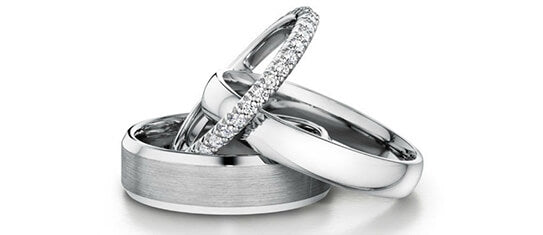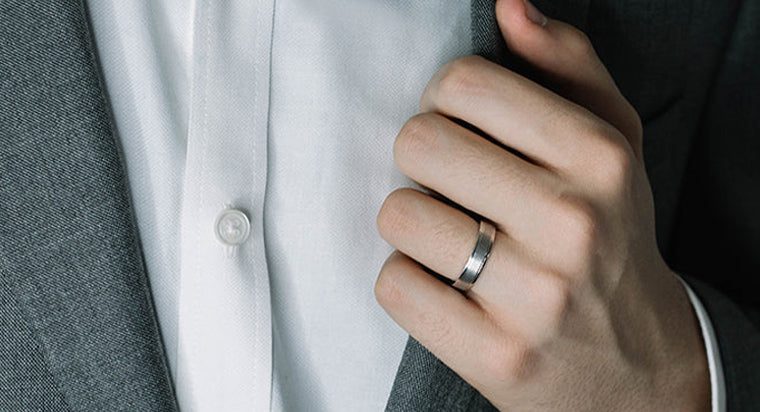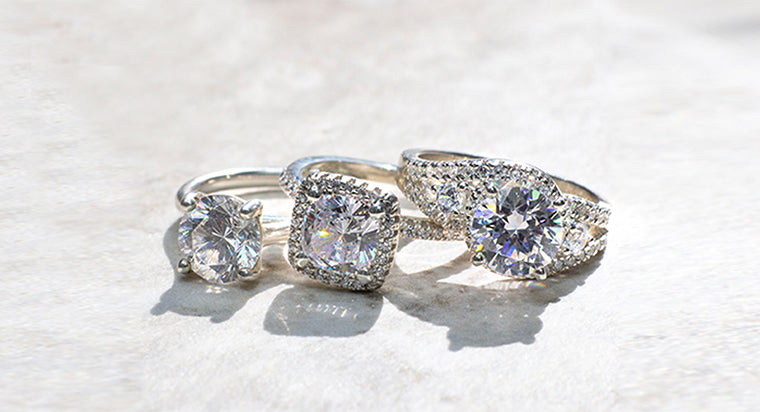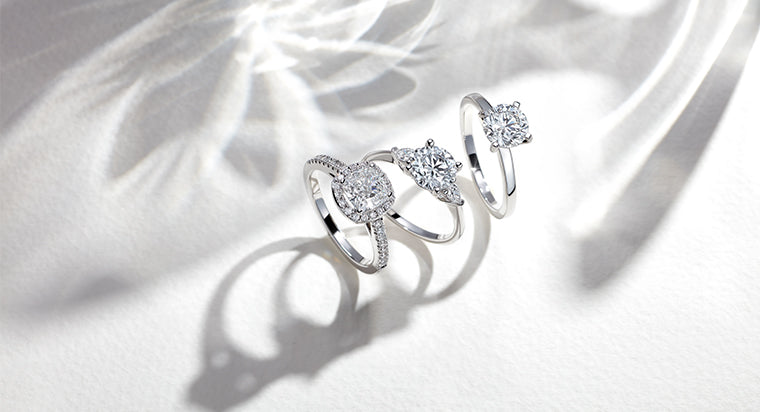Gold Ring Guide

Gold is a sturdy and durable metal that will not corrode, tarnish or rust. These qualities have made gold a preferred choice for crafting jewelry. Gold is also a malleable metal when heated, meaning that jewelers can craft and shape it in myriad of ways. The purity of gold is measured in Karats with 24 Karat gold being the most pure. The word karat is derived from carob. Carobs were seeds used to measure the weight of gold in ancient times. In it’s purest form gold is a bright yellow in color. When being used for jewelry, gold is typically mixed with other metals to create an alloy for both strength and hue. This ensures that the gold will remain strong through the years. The more metals are mixed with gold, the lower the karat becomes. With Clarity crafts jewelry using 14 Karat and 18 Karat gold. These two variation are the most popular within the United States.
TABLE OF CONTENTS
Carat & Metal Percentages
| Carat Metal | Metal % |
|---|---|
| 14kt White Gold | 58.5% pure gold, 10% Copper, 8% Nickel, 4.5% Zinc, 2.5% Silver |
| 18kt White Gold | 75% pure gold, 12% Copper, 8% Nickel, 6% Zinc, 4.5% Silver |
| 14kt Yellow Gold | 58.5% pure gold, 29% copper, 12.5% silver |
| 18kt Yellow Gold | 75% pure gold, 15% copper, 10% silver |
| 14kt Rose Gold | 58.5% pure gold, 41.5% Copper & Silver |
| 18kt Rose Gold | 75% pure gold, 15% Copper, 10% Silver |
14kt White Gold
14k white gold is 58.3% pure gold with a mixture of palladium, zinc, copper, tin and manganese. For an added measure of security, 14k white gold jewelry is typically coated in a protective plating of rhodium. Rhodium is a shining white metal coating that's very similar in appearance to platinum. It adds an extra lustrous shine to the jewelry and makes it more scratch resistant. The pricing of gold is determined by the purity. Therefore, 14k white gold is a less expensive alternative than 18k white gold and is chosen more commonly for jewelry purchases. If you would like to maximize on other elements like larger gems or more design elements, you can opt for 14k gold.
14kt white gold is a versatile metal and is a great choice when paired with any precious or semi-precious gemstone.
14k gold is a durable metal that can be worn daily. It will not rust or corrode and if crafted well should not break. However, over time, gold can become dull or dirty. Regular cleaning can ensure that the gold retains it's original shine and luster. To clean your 14k gold jewelry at home, use a mixture of warm water and a non-abrasive, gentle soap. Gently clean the surface of the gold with a soft-bristled brush to reach corner and hard-to reach spaces. Be sure to reach inside and underneath prongs to remove dirt and grease that can accumulate there. Once cleaned, rinse the jewelry and wipe dry with a soft cloth.
Feel free to wear your gold jewelry on a regular basis. However, be sure to take of rings when doing anything that involves cleaning, heavy labor, gardening or anything involving chemicals or abrasive materials. Also be sure to remove jewelry when swimming or playing sports and exercising. We also recommend removing rings when applying lotions, wax, bleach or harsh soaps to your hands. These chemicals can damage the surface of the gold. Although jewelry is crafted to be durable, it can become damaged if worn without care.
When not wearing jewelry, be sure to place your jewelry in a safe place. Store each piece of jewelry separately in a cloth or plastic bag. This will prevent the jewelry from rubbing against one another and getting scratched.
To ensure that jewelry preserves its beauty for a lifetime, With Clarity offers a lifetime warranty. Be sure to have your jewelry professionally cleaned and inspected by With Clarity periodically to ensure it retains it's beauty forever.

18kt White Gold
14kt = 14/24 = 58.5% pure gold, 10% Copper, 8% Nickel, 4.5% Zinc, 2.5% Silver
18kt white gold is 75% pure gold and 25% alloy metals. It is a great combination of gold purity and strength and is a preferred choice especially for rings. Because 18kt white gold is more pure, it is more expensive than 14kt white gold. In reference to durability, 18kt white gold can be slightly less sturdy than 14kt white gold. However, 18kt white gold is still a good choice for an engagement ring or jewelry worn very regularly. 18kt white gold jewelry is also rhodium plated to ensure durability and add a glowing shine similar to that of platinum.
The gleaming silvery shine of this metal is a perfect match for any precious gemstone or diamond. It complements and balances out vivid gemstone colors like green, red and blue. It is also a good match to sparkling diamonds as it brings out the innate fire of a diamond.

18kt = 18/24 = 75% pure gold, 12% Copper, 8% Nickel, 6% Zinc, 4.5% Silver
14kt Yellow Gold
14kt gold is a classic and traditional choice. It pairs well with all types of gemstones and diamonds. It looks exceptional with ruby and emerald gemstones in particular. Additionally, if purchasing a lower colored diamond, setting it in yellow gold may help to mask some of the yellow tinge of the diamond, causing it to appear more white. 14kt yellow gold is comprised of 58.3% gold and combined with copper and silver. Yellow gold has a radiating warmth that looks beautiful against all skin tones. It is also a traditional choice for wedding bands. 14kt yellow gold is slightly less yellow in tone than 18kt yellow gold.

14kt = 14/24 = 58.5% pure gold, 29% Copper, 12.5% Silver
18kt Yellow Gold
18kt yellow gold is comprised of 75% gold and 25% copper and silver. This higher purity grade means that 18kt yellow gold is more expensive than 14kt yellow gold. With a composition that is more gold, 18kt gold tends to be slightly more malleable than 14kt yellow gold but it is less likely to tarnish. It is difficult to tell the difference in appearance between 14k and 18k yellow gold, they are quite similar in hue. If you prefer jewelry that has a higher composition of gold, you may prefer 18kt yellow gold.
18kt = 18/24 = 75% pure gold, 15% Copper, 10% Silver
14kt Rose Gold
14kt rose gold is another popular metal that is often chosen for it's striking pink hue. It is often considered to be a romantic choice, used commonly for engagement rings and wedding bands. Typically 14kt rose gold is made of a mixture of 58.5% gold, 41.7% copper and other metals. For those that prefer more of a pink champagne color 14kt rose gold is the optimal choice. This metal pairs well will all types of gemstones and diamonds. It looks best with fancy shaped diamonds due to its romantic appeal and deeper colored gemstones like ruby and emerald. Rose gold does not require rhodium plating, but over time if it does get dull it can be repolished to it's original luster. Learn more about Rose Gold Trends.

14kt = 14/24 = 58.5% pure gold, 41.5% Copper & Silver
18kt Rose Gold
18kt rose gold is 75% pure gold and 25% other metals. It offers durability and value and also long-lasting shine. Because it has more gold within it, 18kt rose gold is less pink than 14kt rose gold. Because 18kt rose gold has more gold within the alloy, it is more expensive than 14kt rose gold. Rose gold is a versatile metal that blends well with contemporary designs and vintage styles. For those that want more purity, 18kt rose gold offers more purity in the gold.
18kt = 18/24 = 75% pure gold, 15% Copper, 10% Silver
10kt Gold
While 14kt gold is the classic and traditional choice, 10kt gold is the more durable option (it is difficult to scratch). Although, with 10 out of 24 parts (41.7%) gold and 58.3% alloy, it also doubles as the least pure form of gold used in jewelry. Due to its pale appearance (due to its relatively low gold content), the 10kt gold is not popular as a wedding band or engagement ring. Aesthetically, it is not the best choice. However, it is a standard option for gold earrings and other affordable jewelry. The upsides to using 10kt gold include cost and durability. Therefore, this is an excellent option if you are shopping for gold jewelry on a tight budget. However, the major downside is a higher risk of skin irritation with the 10kt gold. It is not a good option for anyone allergic to copper, silver, nickel, zinc, or iron.
Are you looking out for 10-karat jewelry?
It is pale yellow (the least yellow of all the gold karat types) and is usually stamped with the marking 10K, 10KT, or 0.417
24kt Gold
Often regarded as "pure" gold, the 24kt gold is 99% gold (the meager 1% consists of the alloy used to facilitate melting). It has a unique bright yellow color, and it is not commonly used for jewelry because it is soft and malleable. The 24K gold is used to make coins bars and used in electronics and medical devices. 24kt gold is an excellent option because it is flexible and easy to work with. Furthermore, it is long-lasting and maintains its allure over decades. However, jewelers barely work with it because it requires special techniques. Moreso, 24kt gold is the most expensive kind of gold. Although it screams luxury and is durable, 24kt gold isn't a standard option for engagement rings or wedding bands. This is because it bends and scratches easily.
Alternatives to Gold
Choosing the right wedding band is essential, and in doing that, you should understand your partners' needs and priorities.
You need to pay attention to factors such as:
- Durability (hard or soft metal?)
- Appearance (warm or cooler look?)
- Want to match the wedding ring with the engagement ring?
- Skin type
- Want to have a similar wedding band as your partner?
- Budget
When you consider these factors, it makes it easier to streamline your choice.
Although gold offers variety (yellow, white, and rose gold) in different karat weights, there are other great alternatives for wedding bands.
Platinum
Platinum is an excellent option if you're looking for something similar to white gold or palladium. Its natural white appearance makes it an attractive choice for engagement rings and wedding bands. Besides its natural beauty, platinum is also durable and is far less likely to trigger a skin reaction. Moreso, platinum ages nicely, and you can have it polished regularly to maintain its beauty. The biggest downside of platinum is its cost. It costs almost twice as much as 14k white gold.
Titanium
Titanium is another exciting alternative for a wedding band or engagement ring. It is light gray (can be polished to shine or brushed for a matte look), and it is durable and affordable. As a result of its masculine look, titanium is less appealing for a woman's wedding ring. Furthermore, titanium cannot be resized due to the metal's hardness and resistance to heat. Lastly, titanium is easy to maintain; soap and water are all needed.
Silver
A bride's taste is a massive determinant for choosing silver engagement rings. A Bride that prefers white jewelry would love the idea of a silver engagement ring. Silver looks a lot like platinum and may not be easily differentiated at first glance. Furthermore, it maintains its brightness when cleaned regularly. Although silver is a precious metal, it is significantly more affordable than platinum and gold. Therefore, it is an excellent option if you want to make an impression on a budget. However, with silver, you can have unique and intricate designs- whether you are looking to include colorless or colored stones. The cost of silver engagement rings also depends on the other details (such as knots or molds) asides from the metal. A significant disadvantage with silver is the fact that it may tarnish slowly. Unless properly and regularly cleaned, this is almost inevitable. However, silver is a great initial piece if you plan to upgrade your ring in the future. Other metals include; tungsten carbide, palladium, and others that are less common.
FAQs
Is 14kt Gold real?
Is white gold or platinum better for an engagement ring?
Is silver a good metal for an engagement ring?
What is the difference between a carat and a Karat?
What metal karat should an engagement ring be?









